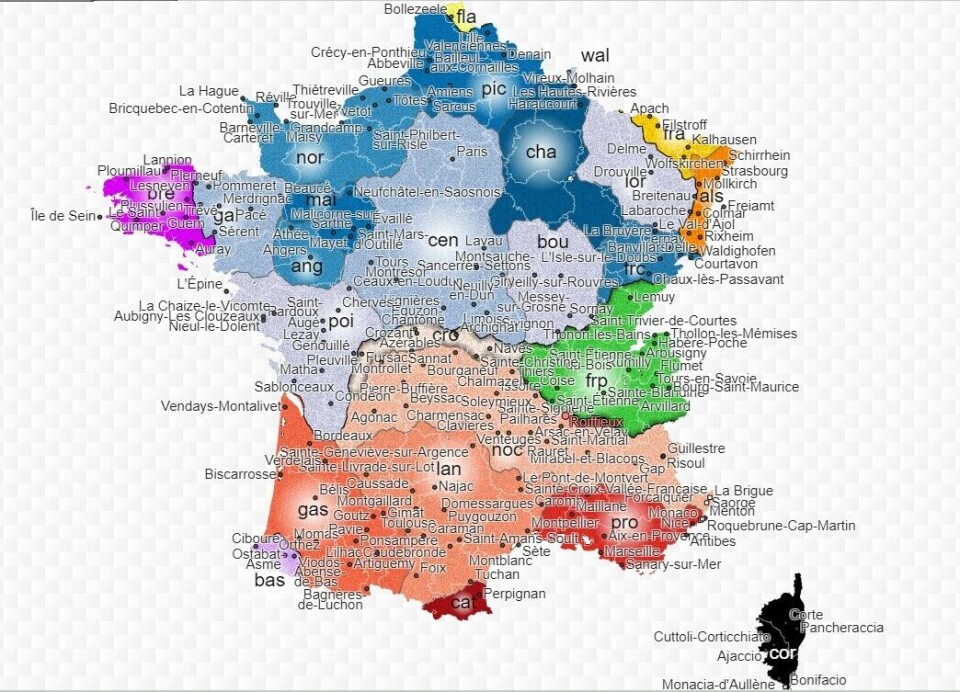-
Learning French: Have you ever dreamt in your target language?
From passive listening to active speaking, dreaming in French can indicate you are regularly practicing it
-
Learning French: what does fastoche mean and when should it be used?
Plus, can you guess the meaning behind more simple slang terms ending in -oche
-
Learning French: when and why do we say montrer patte blanche?
A French fairytale phrase for trustworthiness
LISTEN: Click map allows you to hear 75 local languages of France
But one researcher says that in some areas English can be heard more than any local language

Researchers from a prestigious state laboratory in France have made a ‘listening map’ which allows you to hear the same Aesop fable being read in local regional languages as you click on different areas.
The map features 75 different regional languages and was compiled by the Laboratoire d'Informatique pour la Mécanique et les Sciences de l'Ingénieur (LIMSI), a laboratory associated with the French National Centre for Scientific Research (CNRS).
It features ‘The sun and the wind’ fable from Aesop, a piece which is used by the Association Phonétique Internationale for the study of phonetics and languages.
The atlas specifies the origin of the languages, many of which are categorised under Roman and Germanic heritage while others are listed under Celtic or Occitan origins such as ‘breton’, ‘basque.’
One of the three authors of the atlas told The Connexion of his pessimism about the future of regional languages despite some having reappeared after having been demonised by the government until the late 1960s.
“France benefits from an “unbelievable treasure trove of language variety,” said Philippe Boula de Mareüil, the main initiator of the project, adding that the idea behind the map was to re-establish national pride in regional languages.
Mr Boula de Mareüil took the Atlantic side of the Pyrénées and both La Marche (Creuse) and the Bourdonnais (Auvergne) territories as prime examples of outstanding presence of bilingualism and subtle variations.
You can try out the map here.
The LIMSI laboratory has also studied regional languages in other parts of Europe including Italy, Belgium, Switzerland, Spain and Germany. That map is available here.
Read more: ‘T’as les chocolatines?’ Waze app now offers three more French accents
He said the atlas started with a partnership with the Musée de l’homme in which some translations from the fables were on show during an exhibition in 2014.
‘Dialects are in danger’
Bur Mr Boula de Mareüil also shared concerns about the decline in use of regional languages in France.
“Dialects are in danger,” he said, adding that only the ‘basque’ language is showing an increase in use with the rise of Ikastola schools where courses are taught entirely in ‘basque.’
The ‘diwan’ schools - following the same principle with ‘breton’ - have also witnessed a rise in popularity since the late 1990s.
While article 2 of the Constitution states that French is the official language of France, the ‘Ikastola’ and ‘diwan’ schools have relied on the Molac law promulgated on May 21, 2021 and which bestows “national treasure statute“ to regional languages.
Read more: France adopts historic law to protect its regional languages
The law allows primary schools the possibility of immersive teaching in all regional languages for the majority of the school day.
Mr Boula de Mareüil also mentioned some rural villages in La Marche where English is more spoken than regional languages, attributing the phenomenon to the rise of immigration from British people to the region.
As for the rise of ‘globish English’ or ‘franglais’ within French languages, he said that XVIth century-France faced a similar problem with the introduction of many Italian words before they were assimilated into French in their Italian forms.
“Maybe these English words will meet the same fate,” he said.
Related articles
Hebrew, Spanish, Esperanto: readers speak more than English and French
What is the first ‘swear’ word every French person learns?
























